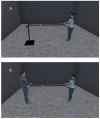Freezing and freeing of degrees of freedom in joint action learning
- PMID: 38078215
- PMCID: PMC10701757
- DOI: 10.3389/fpsyg.2023.1287148
Freezing and freeing of degrees of freedom in joint action learning
Abstract
In daily life, we often encounter situations in which we have to coordinate our actions with others to achieve a common goal. These actions are also defined as joint actions. In this study we investigated how a multi-agent system learns to acquire control in a novel joint action task. To this end, we designed a task in which agents had to coordinate their actions so as to control a ball rolling on a long, hand-held beam. Participants' task was to roll the ball as fast and accurately as possible back-and-forth between two indicated targets on the beam, by manually adjusting the inclination angle of the beam. In the joint action version of this task, two participants each hold a different beam extremity. In a solo action version, the participant holds one extremity while the other is attached to a static support. The experiment consisted of two practice sessions that each comprised 15 two-min trials. One group of 12 participants first performed a solo action session of the task and then a joint action session (Group S/J), while another group of 12 participants started with a joint action session, followed by a solo action session (Group J/S). While performance increased over practice in all sessions, we found that in the joint action task dyads without prior solo task experience (Group J/S) adopted a sequential pattern of interpersonal coordination by freezing their motion whenever the other agent moved. In contrast, dyads that had received prior practice in the solo task setting (Group S/J) demonstrated less freezing and more complementary motion during the joint action performance. Lastly, we found that initial practice as a dyad in the joint action task did not result in a significant improvement of a subsequent solo action performance. We concluded that multi-agent motor learning in a novel joint action task is characterized by the initial freezing of task-relevant degrees of freedom, while individual training in a constrained setting can stimulate the freeing of these DFs during subsequent joint action performance.
Keywords: collaboration; degrees of freedom; interpersonal coordination; joint action; motor control; motor learning.
Copyright © 2023 Hafkamp, Casanova and Bootsma.
Conflict of interest statement
The authors declare that the research was conducted in the absence of any commercial or financial relationships that could be construed as a potential conflict of interest.
Figures






References
-
- Bernstein N. A. (1967). The Co-ordination and Regulation of Movements. Oxford: Pergamon Press.
-
- Bolívar-Vincenty C. G., Beauchamp-Báez G. (2014). “Modelling the ball-and-beam system from Newtonian mechanics and from Lagrange method,” in Twelfth LACCEI Latin American and Caribbean Conference for Engineering and Technology (LACCEI'2014) (Guayaquil; ). Available online at: http://laccei.org/LACCEI2014-Guayaquil/RefereedPapers/RP176.pdf
-
- Butterfill S. (2012). Joint action and development. Philos Q 62, 23–47. 10.1111/j.1467-9213.2011.00005.x - DOI
-
- Debono D., Bugeja M. (2015). “Application of sliding mode control to the ball and plate problem,” in Proceedings of the 12th International Conference on Informatics in Control, Automation and Robotics (Colmar: SCITEPRESS - Science and Technology Publications; ), 412–419. 10.5220/0005569804120419 - DOI
LinkOut - more resources
Full Text Sources

